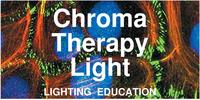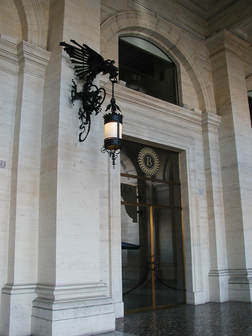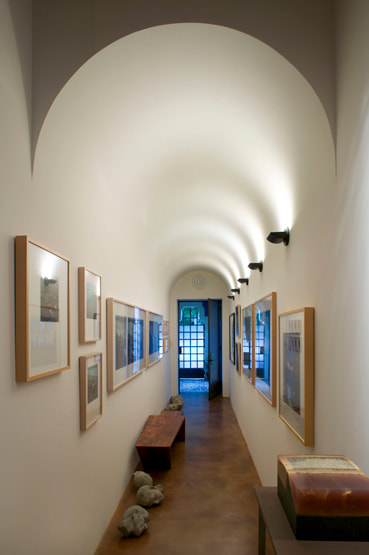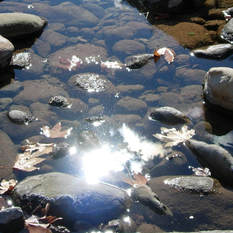Learning Objectives
Lighting Design
Layers of LightIlluminating spaces with layers of light helps us decide where to put the light and why we need it. Light sources can be hidden or featured.There is overlap between the layers when a light source does double duty. For example; a decorative pendant can provide both ambient light and also introduce elements of human scale to the space.
Indirect Lighting Mimics Nature
Building CodesLife safety of building inhabitants is the first and most important reason for building codes. Additionally, energy codes are designed to save energy in order to reduce the need to build new power plants.
The state of California Building Efficiency Standards Title 24 sets standards for energy consumption limits for lighting, heating, and cooling in addition to insulation requirements for windows, walls, and roofing. Commercial buildings and exteriors such as parking lots, over certain sizes, are required to include dimming and daylighting.
ZNE - Zero Net EnergyZNE is an energy-efficient building where, on a source energy basis, the actual annual consumed energy is less than or equal to the on-site renewable generated energy. Or another way to say it, "more electricity is produced on site than is used per year."
The California Public Utilities Commission (CPUC), as part of implementing the California Long-Term Energy Efficiency Strategic Plan and its goal to have all new residential buildings be Zero Net Energy by 2020, and all new commercial buildings be Zero Net Energy beginning in 2030, is updating the Commercial Buildings ZNE Action Plan. https://www.capath2zne.org/ is California's ZNE site to facilitate sharing information, updates, and details about stakeholder input opportunities related to the Plans updates. |
The first national and international ZERO Code standard for new commercial, institutional, and mid- to high-rise residential buildings.Architecture 2030, a non-profit organization established in 2002, is excited to announce the publication of the ZERO Code standard for new building construction, which integrates cost-effective energy efficiency measures with on-site and/or off-site renewable energy resulting in Zero-Net-Carbon (ZNC) buildings.
ZERO Code – Adoption The ZERO Code standard can be incentivized or required by adopting jurisdictions. To access the ZERO Code website, including API documentation and the simulation interface, and to download the ZERO Code and Technical Support Document for the off-site procurement of renewable energy, visit www.zero-code.org November 27, 2018, Oregon Building Codes Division adopted an alternate building code for energy efficiency in commercial structures. The Oregon Zero Code Efficiency Standard, approved by the state's Building Structures Board, offers an alternative approach to meeting the existing code’s energy efficiency requirements. [1] ReflectanceLearn about reflection and glare from nature on https://www.tolighting.com/philosophy.html
Avoid Glare in your artificial and daylighting designGlare is the effect of brightness or differences in brightness within the visual field sufficiently high to cause annoyance, discomfort or loss of visual performance.
Glare – Disability Glare If task performance is affected, it is called disability glare Glare – Discomfort Glare Visual discomfort caused by excessive brightness is called discomfort glare. Glare – Direct Glare Glare resulting from very bright sources of light in the field of view. It usually is associated with bright light from luminaires and windows. A direct glare source may affect occupant’s performance by reducing the apparent contrast of objects in the field of view, especially those near the source of light. Glare – Indirect Glare Glare produced from a reflective surface. Glare – Reflected Glare or Veiling Reflection Glare resulting from bright reflections from polished, glossy, or illuminated objects and surfaces in the field of view. Veiling reflections reduce visual contrast and make it difficult to complete seeing tasks such as reading glossy magazines or looking through windows or at computer screens. Often windows or light fixtures will reflect off surfaces obscuring what is beneath, anticipate this visual obstacle by careful placement of lights, windows, and tasks. Remember with glare, 'the angle of incidence equals the angle of reflection' just like billiards. Visual Comfort Probability (VCP) A rating system for evaluating direct discomfort glare. This method is a subjective evaluation of visual comfort, when viewing from a specific location and in a specified direction, expressed as the percent of occupants of a space who will be bothered by direct glare. VCP allows for several factors: luminaire luminances at different angles of view, luminaire size, room size, luminaire mounting height, illuminance, and room surface reflectivity. VCP tables are often provided as part of photometric reports. Visit Seniors and Low Vision page for more on reflectance.
Learn More
Footnotes
Photo Credits
|
- Home
-
- CHROMA Topics
- Color Spectrum - Light is Energy
- Color in Light
- Color in Nature
- Color in Paint
- Why does paint fade?
- Color Names & Meanings
- Color Phenomena
- Color Perception is Individual
- Color In Fashion
- Color for your home
- Color in Space
- Color Blindness
- Color Blind Interview
- Synesthesia
- Synesthete Deborah Borrowdale-Cox
- Synesthete Stephen Orr, BH&G Editor
-
- Circadian & THERAPY Topics
- Circadian Explained
- Circadian Ganglion Cells
- Circadian Melatonin
- Circadian Animals
- Circadian Research
- Autism & Lighting for the Spectrum
- Blue Light Dimming Apps
- Red Night Lights
- Vitamin D & Light
- SAD - Seasonal Affective Disorder
- Alzheimers and Light Therapy
- Photosensitivity - Light Sensitive Drugs
- Red Light Therapy
- Sleep & Lighting
- Dreams and Second Sleep
- NASA - Lighting in Space & Undersea
- Jet Lag
- Sunglasses
- Chakras
- Crystals, Minerals, & Gemstones
-
- LIGHTing Design Topics
- UV Germicidal Disinfection Light
- LED Lighting Facts Card
- CRI - Color Rendering Index
- LED TM-30
- LED Kelvin Color
- LED LPW
- LED Flicker
- LED Glare
- OLED - Organic LED
- Human Centric Lighting
- Lighting with Daylighting
- Lighting for Healthy Buildings & Zero Net Energy
- Lighting for Healthcare
- Lighting for Horticulture
- Lighting for Hospitality & LED Retrofits
- Lighting for Museums
- Lighting for Seniors & Low Vision
- Lighting Design Tips & Codes
- Parking Lot Lighting
- Solar Lighting for Humanity & World Health
- Davis Insectary Garden
- Santa Barbara Mesa Insectary Garden
- Home
-
- CHROMA Topics
- Color Spectrum - Light is Energy
- Color in Light
- Color in Nature
- Color in Paint
- Why does paint fade?
- Color Names & Meanings
- Color Phenomena
- Color Perception is Individual
- Color In Fashion
- Color for your home
- Color in Space
- Color Blindness
- Color Blind Interview
- Synesthesia
- Synesthete Deborah Borrowdale-Cox
- Synesthete Stephen Orr, BH&G Editor
-
- Circadian & THERAPY Topics
- Circadian Explained
- Circadian Ganglion Cells
- Circadian Melatonin
- Circadian Animals
- Circadian Research
- Autism & Lighting for the Spectrum
- Blue Light Dimming Apps
- Red Night Lights
- Vitamin D & Light
- SAD - Seasonal Affective Disorder
- Alzheimers and Light Therapy
- Photosensitivity - Light Sensitive Drugs
- Red Light Therapy
- Sleep & Lighting
- Dreams and Second Sleep
- NASA - Lighting in Space & Undersea
- Jet Lag
- Sunglasses
- Chakras
- Crystals, Minerals, & Gemstones
-
- LIGHTing Design Topics
- UV Germicidal Disinfection Light
- LED Lighting Facts Card
- CRI - Color Rendering Index
- LED TM-30
- LED Kelvin Color
- LED LPW
- LED Flicker
- LED Glare
- OLED - Organic LED
- Human Centric Lighting
- Lighting with Daylighting
- Lighting for Healthy Buildings & Zero Net Energy
- Lighting for Healthcare
- Lighting for Horticulture
- Lighting for Hospitality & LED Retrofits
- Lighting for Museums
- Lighting for Seniors & Low Vision
- Lighting Design Tips & Codes
- Parking Lot Lighting
- Solar Lighting for Humanity & World Health
- Davis Insectary Garden
- Santa Barbara Mesa Insectary Garden










